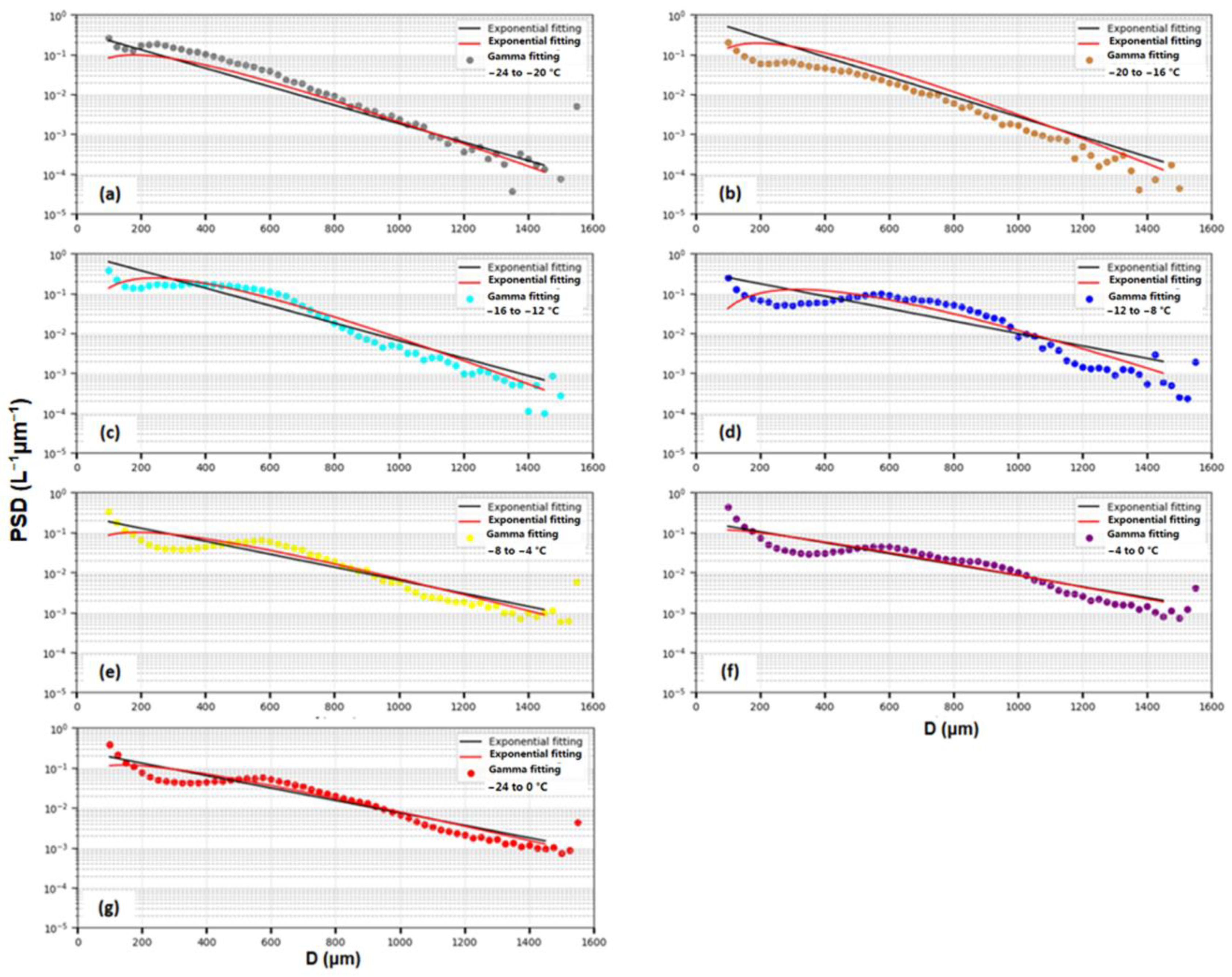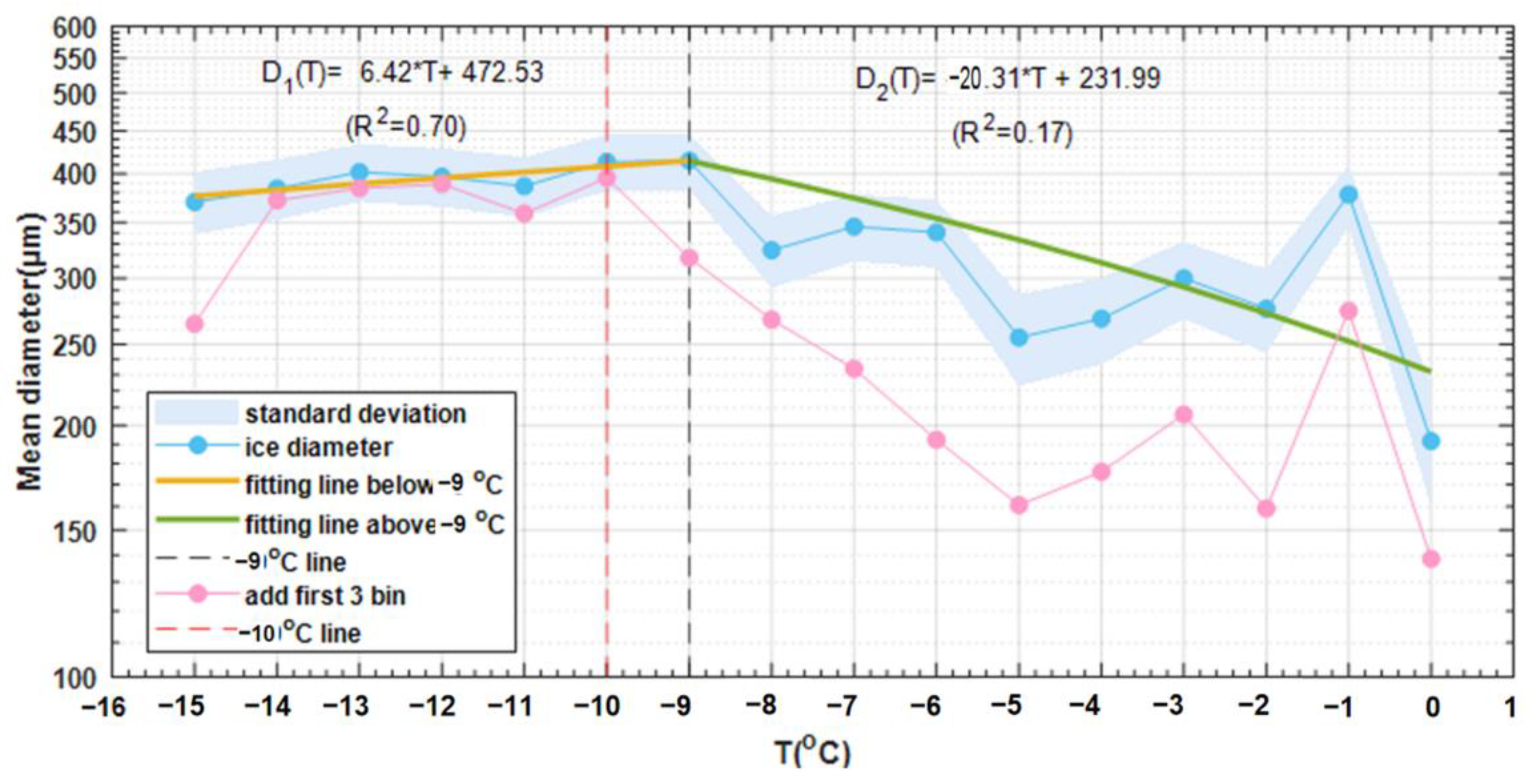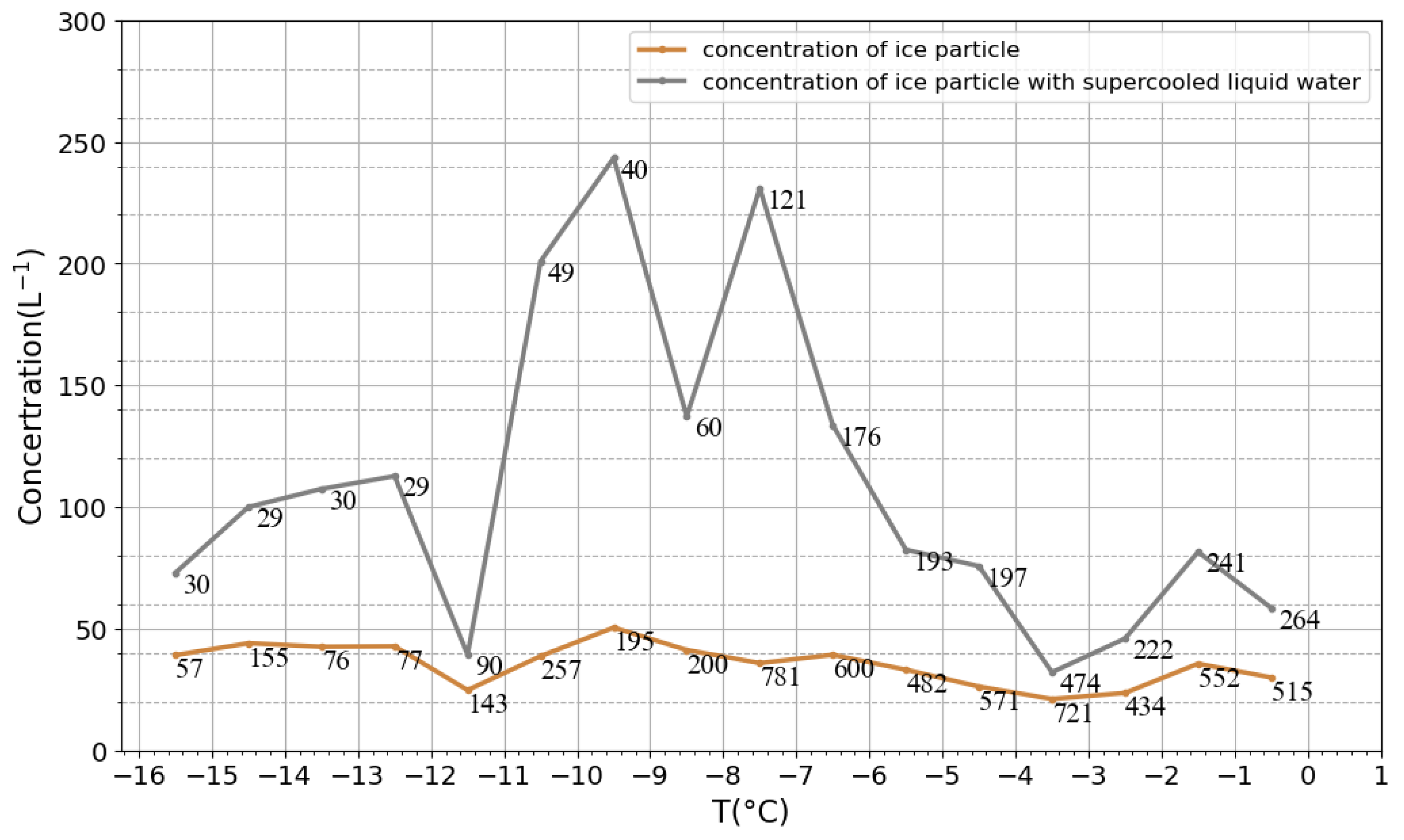Multi-Case Analysis of Ice Particle Properties of Stratiform Clouds Using In Situ Aircraft Observations in Hebei, China
Abstract
1. Introduction
2. Data and Method
2.1. Instrument and Data
2.2. Method
3. Analysis and Results
4. Summary
Author Contributions
Funding
Institutional Review Board Statement
Informed Consent Statement
Data Availability Statement
Conflicts of Interest
References
- Kinne, S.; Liou, K.N. The effects of the non-sphericity and size distribution of ice crystals on the radiative properties of cirrus clouds. Atmos. Res. 1989, 24, 273–284. [Google Scholar] [CrossRef]
- Liou, K.N.; Takano, Y. Light scattered by non-spherical particles: Remote sensing and climate implications. Atmos. Res. 1994, 31, 271–298. [Google Scholar] [CrossRef]
- Mason, B.J. The shapes of snow crystals-Fitness for purpose? Q. J. R. Meteorol. Soc. 1994, 120, 849–860. [Google Scholar]
- Zhang, Y.; Macke, A.; Albers, F. Effect of crystal size spectrum and crystal shape on stratiform cirrus radiative forcing. Atmos. Res. 1999, 52, 59–75. [Google Scholar] [CrossRef]
- Heymsfield, A.J. Properties of tropical and midlatitude ice cloud particle ensembles—Part II: Applications for mesoscale and climate models. J. Atmos. Sci. 2003, 60, 2592–2611. [Google Scholar] [CrossRef]
- Hu, Z.; He, G. Numerical simulation of microphysical processes in cumulonimbus, Part I: Microphysical model. Acta Meteorol. Sin. 1988, 2, 471–489. [Google Scholar]
- Baker, M.B. Cloud microphysics and climate. Science 1997, 276, 1072–1078. [Google Scholar] [CrossRef]
- Stephens, G.L.; Webster, P.J. Clouds and climate: Sensitivity of simple systems. J. Atmos. Sci. 1981, 38, 235–247. [Google Scholar] [CrossRef]
- Evans, A.G.; Locatelli, J.D.; Stoelinga, M.T.; Hobbs, P.V. The IMPROVE-1 storm of 1–2 February 2001. Part II: Cloud structures and the growth of precipitation. J. Atmos. Sci. 2005, 62, 3456–3473. [Google Scholar] [CrossRef]
- Baker, M.B.; Peter, T. Small-scale cloud processes and climate. Nature 2008, 451, 299–300. [Google Scholar] [CrossRef]
- Schiller, C.; Krämer, M.; Afchine, A.; Spelten, N.; Sitnikov, N. The ice water content of Arctic, mid latitude and tropical cirrus. J. Geophys. Res. 2008, 113, 1208–1245. [Google Scholar]
- Zhao, C.; Xie, S.; Klein, S.A.; Protat, A.; Shupe, M.D.; McFarlane, S.A.; Comstock, J.M.; Delanoe, J.; Deng, M.; Dunn, M.; et al. Toward Understanding of Differences in Current Cloud Retrievals of ARM Ground-based Measurements. J. Geophy. Res. 2012, 117, D10206. [Google Scholar] [CrossRef]
- Zhao, C.; Chen, Y.; Li, J.; Letu, H.; Su, Y.; Chen, T.; Wu, X. 15-year statistical analysis of cloud characteristics over China using Terra and Aqua MODIS observations. Int. J. Climatol. 2019, 38, 2612–2629. [Google Scholar] [CrossRef]
- King, M.D.; Platnick, S.; Menzel, W.P.; Ackerman, S.A.; Hubanks, P.A. Spatial and temporal distribution of clouds observed by MODIS onboard the Terra and Aqua satellites. IEEE Trans. Geosci. Remote Sens. 2013, 51, 3826–3852. [Google Scholar] [CrossRef]
- Rangno, A.L.; Hobbs, P.V. Ice particles in stratiform clouds in the Arctic and possible mechanisms for the production of high ice concentrations. J. Geophys. Res. 2001, 106, 15065–15075. [Google Scholar] [CrossRef]
- You, L.; Xiong, G.; Gao, M.; Lu, Y.; Sun, K.; Ren, D. The characteristics of ice crystal formation and snow growth processes of in spring stratiform clouds in Jilin Province. Acta Meteorol. Sin. 1965, 35, 423–433. (In Chinese) [Google Scholar]
- Delanoë, J.; Protat, A.; Testud, J.; Bouniol, D.; Forbes, R.M. Statistical properties of the normalized ice particle size distribution. J. Geophys. Res. Atmos. 2005, 110, 10201–10223. [Google Scholar] [CrossRef]
- Heymsfield, A.J.; Schmitt, C.; Bansemer, A. Ice cloud particle size distributions and pressure-dependent terminal velocities from in situ observations at temperatures from 0 to −86 °C. J. Atmos. Sci. 2013, 70, 4123–4154. [Google Scholar] [CrossRef]
- Yuan, F.; Lei, H.C. Aircraft observation of cloud microphysical characteristics of pre-stratiform-cloud precipitation in Jiangxi province. Atmos. Ocean. Sci. Lett. 2017, 10, 364–371. [Google Scholar]
- Yang, J.; Lei, H.; Hu, Z.; Hou, T. Particle size spectra and possible mechanisms of high ice concentration in nimbostratus over Hebei province, China. Atmos. Res. 2014, 142, 79–90. [Google Scholar] [CrossRef]
- Zhen, Z.; Lei, H. Observed microphysical structure of nimbostratus in northeast cold vortex over China. Atmos. Res. 2014, 142, 91–99. [Google Scholar]
- Li, T.L.; Bin, Y.; Guo, X.L.; Shao, Z.P. Analysis on the macro and micro physical characteristics of stratiform cloud in Henan. Meteorol. Environ. Res. 2010, 1, 96–100. [Google Scholar]
- Hou, T.; Lei, H.; Hu, Z. A comparative study of the microstructure and precipitation mechanisms for two stratiform clouds in China. Atmos. Res. 2010, 96, 447–460. [Google Scholar] [CrossRef]
- Hou, T.; Lei, H.; Hu, Z.; Zhou, J. Aircraft observations of ice particle properties in stratiform precipitating clouds. Adv. Meteorol. 2014, 2014, 1–12. [Google Scholar] [CrossRef]
- Zhu, S.; Guo, X.; Lu, G.; Li, J. Ice crystal habits and growth processes in stratiform clouds with embedded convection examined through aircraft observation in northern China. J. Atmos. Sci. 2015, 72, 2011–2032. [Google Scholar] [CrossRef]
- Zhao, C.; Zhao, L.; Dong, X. A case study of stratus cloud properties using in situ aircraft observations over Huanghua, China. Atmosphere 2019, 10, 19. [Google Scholar] [CrossRef]
- Strapp, J.W.; Albers, F.; Reuter, A.; Korolev, A.V.; Maixner, U.; Rashke, E.; Vukovic, Z. Laboratory measurements of the response of a PMS OAP-2DC. J. Atmos. Oceanic Technol. 2001, 18, 1150–1170. [Google Scholar] [CrossRef]
- Knollenberg, R.G. The optical array: An alternative to scattering or extinction for airborne particle size determination. J. Appl. Meteorol. 1970, 9, 86–103. [Google Scholar] [CrossRef]
- Mcfarquhar, G.M.; Cober, S.G. Single-scattering properties of mixed-phase Arctic clouds at solar wavelengths: Impacts on radiative transfer. J. Clim. 2004, 17, 3799–3813. [Google Scholar] [CrossRef]
- Mcfarquhar, G.M.; Zhang, G.; Poellot, M.R.; Kok, G.L.; Mccoy, R.; Tooman, T.; Fridlind, A.; Hemsfield, A.J. Ice properties of single-layer stratocumulus during the mixed-phase Arctic cloud experiment. I: Observations. J. Geophys. Res. Atmos. 2007, 112, 1201–1224. [Google Scholar] [CrossRef]
- Burnet, F.; Brenguier, J.L. Comparison between standard and modified forward scattering spectrometer probes during the small cumulus microphysics study. J. Atmos. Ocean. Technol. 2010, 19, 1516–1531. [Google Scholar] [CrossRef]
- Yang, Y.; Zhao, C.; Dong, X.; Fan, G.; Zhou, Y.; Wang, Y.; Zhao, L.; Lv, F.; Yan, F. Toward understanding the process-level impacts of aerosols on microphysical properties of shallow cumulus cloud using aircraft observations. Atmos. Res. 2019, 221, 27–33. [Google Scholar] [CrossRef]
- Jensen, E.J.; Lawson, P.; Baker, B.; Pilson, B.; Mo, Q.; Heymsfield, A.J.; Bansemer, A.; Bui, T.P.; McGill, M.; Hlavka, D.; et al. On the importance of small ice crystals in tropical anvil cirrus. Atmos. Chem. Phys. 2009, 9, 5519–5537. [Google Scholar] [CrossRef]
- McFarquhar, G.M.; Finlon, J.A.; Stechman, D.M.; Wu, W.; Jackson, R.C.; Freer, M. University of Illinois/Oklahoma Optical Array Probe (OAP) Processing Software; Zenodo: Genève, Switzerland, 2018. [Google Scholar] [CrossRef]
- Claffey, K.J.; Jones, K.F.; Ryerson, C.C. Use and Calibration of Rosemount Ice Detectors for Meteorological Research. Atmos. Res. 1995, 36, 277–286. [Google Scholar] [CrossRef]
- Cober, S.G.; Isaac, G.A.; Strapp, J.W. Aircraft Icing Measurements in East Coast Winter Storms. J. Appl. Meteorol. 1995, 34, 88–100. [Google Scholar] [CrossRef]
- Rangno, A.L.; Hobbs, P.V. Microstructures and precipitation development in cumulus and small cumulonimbus clouds over the warm pool of the tropical Pacific Ocean. Q. J. R. Meteorol. Soc. 2005, 131, 639–673. [Google Scholar] [CrossRef]
- Gultepe, I.; Isaac, G.A.; Leaitch, W.R.; Banic, C.M. Parameterization of marine stratus microphysics based on in situ observations: Implications for GCMs. J. Clim. 1996, 9, 345–357. [Google Scholar] [CrossRef][Green Version]
- Gultepe, I.; Isaac, G.A. Aircraft observations of cloud droplet number concentration: Implications for climate studies. Q. J. R. Meteorol. Soc. 2004, 130, 2377–2390. [Google Scholar] [CrossRef]
- Zhang, Q.; Quan, J.; Tie, X.; Huang, M.; Ma, X. Impact of aerosol particles on cloud formation: Aircraft measurements in China. Atmos. Environ. 2011, 45, 665–672. [Google Scholar] [CrossRef]
- Cober, S.G.; Isaac, G.A.; Korolev, A.V. Assessing cloud-phase conditions. J. Appl. Meteorol. Clim. 2001, 40, 1967–1983. [Google Scholar] [CrossRef]
- Wang, L.J.; Yin, Y.; Yao, Z. Microphysical responses to catalysis during a stratocumulus aircraft seeding experiment over the Sanjiangyuan region of China. J. Meteorol. Res. 2014, 27, 849–867. [Google Scholar] [CrossRef]
- Liu, Y.; You, L.; Yang, W.; Liu, F. On the size distribution of cloud droplets. Atmos. Res. 1995, 35, 201–216. [Google Scholar] [CrossRef]
- Best, A.C. Dropsize distribution in cloud and fog. Q. J. R. Meteorol. Soc. 1951, 77, 418–426. [Google Scholar] [CrossRef]
- Kosarev, A.L.; Mazin, I.P. An empirical model of the physical structure of upper-layer clouds. Atmos. Res. 1991, 26, 213–228. [Google Scholar] [CrossRef]
- Levin, L.M. On the size distributions functions of the cloud and rain droplets. Dokl. Acad. Sci. USSR 1954, 44, 1045–1049. [Google Scholar]
- Deirmendjian, D. Scattering and polarization properties of water clouds and hazes in the visible and infrared. Appl. Opt. 1964, 3, 187–196. [Google Scholar] [CrossRef]
- Tampieri, F.; Tomasi, C. Size distribution models of fog and cloud droplets in terms of the modified gamma function. Tellus 1976, 28, 333–347. [Google Scholar] [CrossRef][Green Version]
- Schumann, T.E.W. Theoretical aspects of the size distribution of fog particles. Q. J. R. Meteorol. Soc. 2010, 66, 195–208. [Google Scholar] [CrossRef]
- Ivanova, D.; Mitchell, D.L.; Arnott, W.P.; Poellot, M. A gcm parameterization for bimodal size spectra and ice mass removal rates in mid-latitude cirrus clouds. Atmos. Res. 2001, 59, 89–113. [Google Scholar] [CrossRef]
- Liu, Y.; Hallett, J. The “1/3” power-law between effective radius and liquid-water content. Q. J. R. Meteorol. Soc. 1997, 123, 1789–1795. [Google Scholar]
- Costa, A.A.; Oliveira, C.J.; Oliveira, J.C.P.; Sampaio, A.J.C. Microphysical observations of warm cumulus clouds in CEARA, Brazil. Atmos. Res. 2000, 54, 167–199. [Google Scholar] [CrossRef]
- Liu, Y.; Daum, P.H. Spectral dispersion of cloud droplet size distributions and the parameterization of cloud droplet effective radius. Geophys. Res. Lett. 2000, 27, 1903–1906. [Google Scholar] [CrossRef]
- Khrgian, A.K.; Mazin, I.P. Analysis of methods of characterization of distribution spectra of cloud droplets. Tr. TsAo. 1952, 7, 92–126. [Google Scholar]
- Heymsfield, A.J.; Platt, C.M.R. A parameterization of the particle size spectrum of ice clouds in terms of the ambient temperature and the ice water content. J. Atmos. Sci. 1984, 41, 846–855. [Google Scholar] [CrossRef]
- Arnott, W.P.; Dong, Y.Y.; Hallett, J. Role of small ice crystals in radiative properties of cirrus: A case study, FIRE II, 22 November 1991. J. Geophys. Res. 1994, 99, 1371–1381. [Google Scholar] [CrossRef]
- Mcfarquhar, G.M.; Heymsfield, A.J. Parameterization of tropical cirrus ice crystal size distributions and implications for radiative transfer: Results from CEPEX. J. Atmos. Sci. 1997, 54, 2187–2200. [Google Scholar] [CrossRef]
- Platt, C.M.R. A parameterization of the visible extinction coefficient of ice clouds in terms of the ice/water content. J. Atmos. Sci. 1997, 54, 2083–2098. [Google Scholar] [CrossRef]
- Puechel, R.F.; Hallett, J.; Strawa, A.W.; Howard, S.D.; Ferry, G.V.; Foster, T.; Arnott, W.P. Aerosol and cloud particles in tropical cirrus anvil: Importance to radiation balance. J. Aerosol Sci. 1997, 28, 1123–1136. [Google Scholar] [CrossRef]
- Ryan, B.F. A bulk parameterization of the ice particle size distribution and the optical properties in ice clouds. J. Atmos. Sci. 2000, 57, 1436–1451. [Google Scholar] [CrossRef]
- Gunn, K.L.S.; Marshall, J.S. The distribution with size of aggregate snowflakes. J. Atmos. Sci. 1958, 15, 452–461. [Google Scholar] [CrossRef]
- Che, Y.; Zhang, J.; Zhao, C.; Fang, W.; Xue, W.; Yang, W.; Ji, D.; Dang, J.; Duan, J.; Sun, J.; et al. A study on the characteristics of ice nucleating particles concentration and aerosols and their relationship in spring in Beijing. Atmos. Res. 2020, 247, 105196. [Google Scholar] [CrossRef]
- Mertes, S.; Schwarzenbock, A.; Laj, P.; Wobrock, W.; Pichon, J.M.; Orsi, G.; Heintzenberg, J. Changes of cloud microphysical properties during the transition from supercooled to mixed-phase conditions during CIME. Atmos. Res. 2001, 58, 267–294. [Google Scholar] [CrossRef]
- Mason, B.J. The Physics of Clouds; Oxford University Press: Oxford, UK, 1971; 660p. [Google Scholar]
- Tribus, M. Physical view of cloud seeding. Science 1970, 168, 201–211. [Google Scholar] [CrossRef] [PubMed]
- Zettlemoyer, A.C. Microphysics of clouds and precipitation. J. Colloid Interface Sci. 1979, 70, 289–290. [Google Scholar] [CrossRef]
- Fukuta, N. Water supersaturation in convective clouds. Atmos. Res. 1993, 30, 105–126. [Google Scholar] [CrossRef]






| Year | Flight | Season | Flight Time (Beijing Time) | Ground Temperature (°C) | Highest Height (m) | Cloud | Total Number of PSDs |
|---|---|---|---|---|---|---|---|
| 2008 | 20080408f1 | Spring | 12:23–12:39 | 14 | 6000 | Stratus | 615 |
| 20080408f3 | Spring | 20:15–22:22 | 16 | 6000 | Stratus | 2723 | |
| 20080522f1 | Spring | 19:15–21:55 | 13 | 6000 | Stratus | 1600 | |
| 20080526f1 | Spring | 10:48–13:37 | 13 | 6000 | Stratus | 280 | |
| 20081005f1 | Autumn | 08:45–11:17 | 11 | 6084 | Stratus | 1880 | |
| 20081020f1 | Autumn | 19:47–22:07 | 19 | 5500 | Stratus | 1219 | |
| 20081021f1 | Autumn | 10:39–12:49 | 16 | 3900 | Stratus | 870 | |
| 20081022f1 | Autumn | 21:14–23:07 | 13 | 5700 | Stratus | 672 | |
| 2009 | 20090324f1 | Spring | 07:50–10:46 | 2 | 3000 | Stratus | 3583 |
| 20090329f2 | Spring | 16:00–19:18 | 8 | 4300 | Stratus | 1180 | |
| 20090509f1 | Spring | 13:43–16:22 | 27 | 5800 | Stratus | 2339 | |
| 20090510f1 | Spring | 09:52–12:56 | 14 | 6000 | Stratus | 965 | |
| 20090514f1 | Spring | 14:24–17:07 | 18 | 7000 | Stratus | 1173 | |
| 20090908f1 | Autumn | 13:40–16:43 | 17 | 6600 | Stratus | 634 | |
| 20090928f1 | Autumn | 15:01–17:33 | 14 | 6800 | Stratus | 1006 | |
| 20091011f1 | Autumn | 10:08–13:07 | 14 | 7000 | Stratus | 500 | |
| 20091011f2 | Autumn | 16:06–18:22 | 10 | 7000 | Stratus | 525 | |
| 20091025f1 | Autumn | 15:01–17:37 | 22 | 7000 | Stratus | 604 | |
| 2013 | 20130404f1 | Spring | 14:40–17:35 | 16 | 6000 | Stratus | 5103 |
| 20130404f2 | Spring | 20:50–23:22 | 18 | 7000 | Stratus | 941 | |
| 20130419f1 | Spring | 09:40–12:33 | 15 | 6400 | Stratus | 5043 | |
| 20130921f1 | Autumn | 11:30–14:18 | 16 | 7000 | Stratus | 4001 | |
| 20130921f2 | Autumn | 16:55–18:45 | 18 | 6800 | Stratus | 537 | |
| 20130922f1 | Autumn | 19:10–21:55 | 15 | 7000 | Stratus | 1586 | |
| 20130923f1 | Autumn | 10:28–13:28 | 15 | 7000 | Stratus | 3177 | |
| 20131013f1 | Autumn | 09:05–11:30 | 18 | 7000 | Stratus | 1318 | |
| 20131013f2 | Autumn | 19:33–23:01 | 14 | 4800 | Stratus | 3250 | |
| 20131014f1 | Autumn | 09:43–12:00 | 13 | 6800 | Stratus | 1201 | |
| 20131014f2 | Autumn | 14:17–17:24 | 14 | 6400 | Stratus | 3678 |
| Temperature (°C) | Exponential n(D) = N0 exp(−λD) | Gamma n(D) = N0Dµ exp(−λD) | |||||||
|---|---|---|---|---|---|---|---|---|---|
| N0 | λ | R2 | RMSE | N0 | µ | λ | R2 | RMSE | |
| −24–−20 | 0.3826 | 0.005338 | 0.89 | 0.0227 | 0.000386 | 0.0075 | 1.3253 | 0.71 | 0.0201 |
| −20–−16 | 0.8851 | 0.005783 | 0.78 | 0.0671 | 0.000200 | 0.0084 | 1.6131 | 0.92 | 0.0194 |
| −16–−12 | 1.0338 | 0.005059 | 0.65 | 0.0983 | 0.000034 | 0.0083 | 1.9866 | 0.70 | 0.0484 |
| −12–−8 | 0.3614 | 0.003596 | 0.51 | 0.0460 | 0.000002 | 0.0074 | 2.3500 | 0.27 | 0.0433 |
| −8–−4 | 0.2717 | 0.003748 | 0.64 | 0.0328 | 0.001373 | 0.0054 | 1.0158 | 0.38 | 0.0428 |
| −4–0 | 0.1976 | 0.003164 | 0.58 | 0.0450 | 0.044375 | 0.0036 | 0.2870 | 0.49 | 0.0493 |
| −24–0 | 0.2687 | 0.003585 | 0.67 | 0.0354 | 0.008663 | 0.0047 | 0.6598 | 0.48 | 0.0447 |
Publisher’s Note: MDPI stays neutral with regard to jurisdictional claims in published maps and institutional affiliations. |
© 2022 by the authors. Licensee MDPI, Basel, Switzerland. This article is an open access article distributed under the terms and conditions of the Creative Commons Attribution (CC BY) license (https://creativecommons.org/licenses/by/4.0/).
Share and Cite
Liu, S.; Zhao, C.; Zhou, Y.; Wu, Z.; Hu, Z. Multi-Case Analysis of Ice Particle Properties of Stratiform Clouds Using In Situ Aircraft Observations in Hebei, China. Atmosphere 2022, 13, 200. https://doi.org/10.3390/atmos13020200
Liu S, Zhao C, Zhou Y, Wu Z, Hu Z. Multi-Case Analysis of Ice Particle Properties of Stratiform Clouds Using In Situ Aircraft Observations in Hebei, China. Atmosphere. 2022; 13(2):200. https://doi.org/10.3390/atmos13020200
Chicago/Turabian StyleLiu, Siyao, Chuanfeng Zhao, Yuquan Zhou, Zhihui Wu, and Zhijin Hu. 2022. "Multi-Case Analysis of Ice Particle Properties of Stratiform Clouds Using In Situ Aircraft Observations in Hebei, China" Atmosphere 13, no. 2: 200. https://doi.org/10.3390/atmos13020200
APA StyleLiu, S., Zhao, C., Zhou, Y., Wu, Z., & Hu, Z. (2022). Multi-Case Analysis of Ice Particle Properties of Stratiform Clouds Using In Situ Aircraft Observations in Hebei, China. Atmosphere, 13(2), 200. https://doi.org/10.3390/atmos13020200







